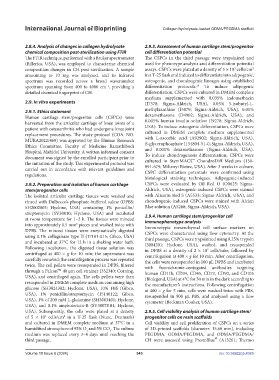Page 351 - IJB-10-6
P. 351
International Journal of Bioprinting Collagen hydrolysate-loaded ODMA/PEGDMA scaffold
2.8.4. Analysis of changes in collagen hydrolysate 2.9.3. Assessment of human cartilage stem/progenitor
chemical composition post-sterilization using FTIR cell differentiation potential
The FTIR technique, performed with a Bruker spectrometer The CSPCs in the third passage were trypsinized and
(Billerica, USA), was employed to characterize chemical used for phenotype analysis and differentiation potential
3
2
composition changes in CH post-sterilization. A sample assays. CSPCs were plated at a density of 5 × 10 cells/cm
amounting to 10 mg was analyzed, and its infrared in a T-25 flask and induced to differentiate into adipogenic,
spectrum was recorded across a broad wavenumber osteogenic, and chondrogenic lineages using established
20
spectrum spanning from 400 to 4000 cm , providing a differentiation protocols. To induce adipogenic
−1
detailed chemical fingerprint of CH. differentiation, CSPCs were cultured in DMEM complete
medium supplemented with 0.035% indomethacin
2.9. In vitro experiments (I7378; Sigma-Aldrich, USA), 0.03% 3-isobutyl-1-
2.9.1. Ethics statement methylxanthine (I5879; Sigma-Aldrich, USA), 0.01%
Human cartilage stem/progenitor cells (CSPCs) were dexamethasone (D4902; Sigma-Aldrich, USA), and
harvested from the articular cartilage of knee joints of a 0.005% human insulin solution (I9278; Sigma-Aldrich,
patient with osteoarthritis who had undergone knee joint USA). To induce osteogenic differentiation, CSPCs were
replacement procedures. The study protocol (COA. NO. cultured in DMEM complete medium supplemented
MURA2022/469) was approved by the Human Research with L-ascorbic acid (A92902; Sigma-Aldrich, USA),
Ethics Committee, Faculty of Medicine Ramathibodi B-glycerophosphate (154804-51-0; Sigma-Aldrich, USA),
Hospital, Mahidol University. A written informed consent and 0.001% dexamethasone (Sigma-Aldrich, USA).
document was signed by the enrolled participant prior to To induce chondrogenesis differentiation, CSPCs were
the initiation of the study. This experimental protocol was cultured in StemMACS™ ChondroDiff Medium (130-
091-679; Miltenyi Biotec, USA). After 3 weeks in culture,
carried out in accordance with relevant guidelines and CSPC differentiation potentials were confirmed using
regulations.
histological staining techniques. Adipogenic-induced
2.9.2. Preparation and isolation of human cartilage CSPCs were evaluated by Oil Red O (O0625; Sigma-
stem/progenitor cells Aldrich, USA), osteogenic-induced CSPCs were stained
The isolated articular cartilage tissues were washed and with Alizarin Red S (A5533; Sigma-Aldrich, USA), and
rinsed with Dulbecco’s phosphate-buffered saline (DPBS; chondrogenic-induced CSPCs were stained with Alcian
SH2002803; Hyclone, USA) containing 1% penicillin/ Blue solution (A5268; Sigma-Aldrich, USA).
streptomycin (SV30010; Hyclone, USA) and incubated 2.9.4. Human cartilage stem/progenitor cell
at room temperature for 1–2 h. The tissues were minced immunophenotype analysis
into approximately 0.5 mm pieces and washed twice with Immunotypic mesenchymal cell surface markers on
3
DPBS. The minced tissues were enzymatically digested CSPCs were characterized using flow cytometry. At the
using 0.1% collagenase type II (17101-015; Gibco, USA) third passage, CSPCs were trypsinized using 0.25% trypsin
and incubated at 37°C for 12 h in a shaking water bath. (3004201; Hyclone, USA), washed, and resuspended
Following incubation, the digested tissue solution was in DPBS at a density of 2 × 10 cells/tube, followed by
5
centrifuged at 400 × g for 10 min; the supernatant was centrifugation at 400 × g for 10 min. After centrifugation,
carefully removed; the centrifugation process was repeated the cells were resuspended in 100 µL DPBS and incubated
twice. The cell pellets were resuspended in DPBS, filtered with fluorochrome-conjugated antibodies targeting
through a Falcon 40 µm cell strainer (352340; Corning, human CD11b, CD34, CD45, CD73, CD90, and CD105
TM
USA), and centrifuged again. The cells pellets were then (Biolegend, USA) at 4°C for 30 min in the dark according to
resuspended in DMEM complete medium containing high the manufacturer’s instructions. Following centrifugation
glucose (SH3024302; Hyclone, USA), 10% FBS (Gibco, at 400 × g for 5 min, cells were washed twice with PBS,
USA), 1% penicillin/streptomycin (15140122; Gibco, resuspended in 500 µL PBS, and analyzed using a flow
USA), 1% of 200 mM L-glutamine (SH3003401; Hyclone, cytometer (Beckman Coulter, USA).
USA), and 0.1% amphotericin-B (SV30078.01; Hyclone,
USA). Subsequently, the cells were plated at a density 2.9.5. Cell viability analysis of human cartilage stem/
of 5 × 10 cells/cm in a T-25 flask (Nunc, Denmark) progenitor cells on resin scaffolds
2
3
and cultured in DMEM complete medium at 37°C in a Cell viability and cell proliferation of CSPCs on a series
humidified atmosphere of 95% O and 5% CO . The culture of 3D-printed scaffolds (diameter: 15.60 mm), including
2
2
medium was replaced every 3–4 days until reaching the PEGDMA, ODMA/PEGDMA, and ODMA/PEGDMA/
third passage. CH were assessed using PrestoBlue® (A13261; Thermo
Volume 10 Issue 6 (2024) 343 doi: 10.36922/ijb.4385

